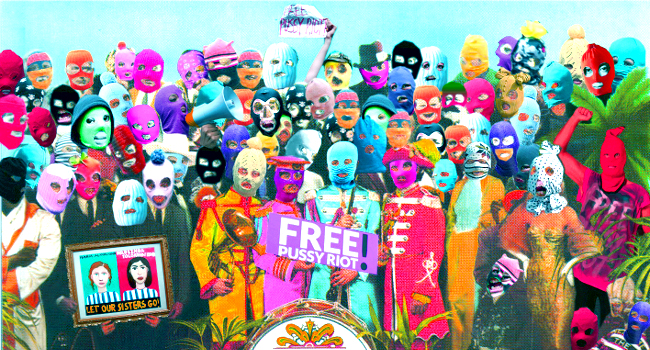As any fan of the Coincidence Control Network knows, we’ve been following the Pussy Riot story very closely since the band/action art collective’s infamous performance at Moscow’s Cathedral of Christ the Savior on February 21, 2012. Although the podcast has committed itself to being a weekly at this point, we’ve experienced a number of technical difficulties that have made our reports more erratic just at a point when the Pussy Riot story has had some major developments.
Here’s the back story: On February 21, 2012 Pussy Riot performs their “Punk Prayer” at the cathedral and by that evening a video of the song has gone viral on the internet. The performance accuses Vladimir Putin of being a tyrant and warns against corrupt ties between Putin and the Orthodox Church. The girls are famous. Their feminist, anti-Putin message is heard around the world and their colorful, knitted balaclava masks become iconic.
In March, 3 of the members of the group are arrested. They are convicted of “hooliganism motivated by religious hatred.” Yekaterina Samutsevich is set free, but Nadezhda Tolokonnikova and Maria Alyokhina are sent to separate prisons to serve 2 year sentences. An international backlash pressures Putin to free the girls and on December 23, 2013 they are released from prison in a gesture that is widely seen as a PR stunt in preparation for the coming Winter Olympics in Russia.
So where did Pussy Riot come from? The Wiki has a nice breakdown:
The group cites punk rock and Oi! bands Angelic Upstarts, Cockney Rejects, Sham 69 and The 4-Skins as their main musical influences. The band also cite American punk rock band Bikini Kill, Karen Finley and the Riot grrrl movement of the 1990s as inspirations. They stated:
“What we have in common is impudence, politically loaded lyrics, the importance of feminist discourse and a non-standard female image. The difference is that Bikini Kill performed at specific music venues, while we hold unsanctioned concerts. On the whole, Riot Grrrl was closely linked to Western cultural institutions, whose equivalents don’t exist in Russia.”
Tolokonnikova, her husband Pyotr Verzilov, and Samutsevich were all members of the anarchist art collective “Voina” from the group’s early days in 2007, until an acrimonious split in 2009. Following the split, they formed a separate Moscow-based group, also named “Voina”, saying that they had as much right to use this name as Voina founder Oleg Vorotnikov. Pussy Riot is usually considered to be an offshoot of the “Moscow faction” of Voina.
“Voina” is Russian for “War.”
True to their punk/anarchist roots, the band is now resisting efforts to “brand” its image. They’re also claiming that their musical projects may be abandoned in favor of more direct political actions. Here’s The Wall Street Journal‘s take:
“Talking about the brand isn’t really interesting to me,” Ms. Tolokonnikova said.
When the two women returned to Moscow they said they planned to focus on creating a human-rights organization and that they had outgrown Pussy Riot.
“We are not Pussy Riot now,” Ms. Tolokonnikova said.
“We can promote our cause without playing any shows,” Ms. Alyokhina said. “And we will never play any shows for money.”
Even if the band won’t promote their brand, Tolokonnikova was fresh out of prison when she posed for a slide show on the Trend Brands fashion retail site, modeling clothes and returning a favor. Again, from WSJ:
On Tuesday, Ms. Tolokonnikova posted a link to the spread on her Facebook page with the note: “My cool capitalist friends, Trend Brands, supplied me with clothes during the long days at penal colonies where the internal regulations allowed me to freely wear clothes brought by relatives.”
For the best account of the Pussy Riot story I’ve seen yet, watch the documentary film Pussy Riot: A Punk Prayer on my YouTube Channel
Stay Awake!
Please subscribe to my YouTube channel where I archive all of the videos I curate at Insomnia. Click here to check out more Music posts.










